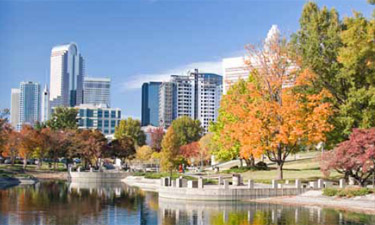 The justifications for cutting county park and recreation budgets have become so common that it begs the question: Are these cuts actually saving money? What are the true benefits of park and recreation services? Can these benefits be quantified?
The justifications for cutting county park and recreation budgets have become so common that it begs the question: Are these cuts actually saving money? What are the true benefits of park and recreation services? Can these benefits be quantified?
Unfortunately, administrators often depend solely on anecdotal evidence, visitation estimates, or vague “quality of life” statements to justify—or, more often, cut—park and recreation services. However, there is reliable research out there to assist decision makers. If return on investment (ROI) is important to your community, it is your responsibility to prove how your parklands add real value.
Environmental Benefits
The benefits of protecting open space, tree canopies, and watersheds are extensive, as there are direct correlations to water quality. Even relatively impermeable soils, such as those found in Mecklenburg County (Charlotte, North Carolina), can absorb a one-inch rainfall. Remove those trees and replace them with roads, parking lots, and roofs, and the same rainfall produces 27,000 gallons of runoff per acre. A 2010 Trust for Public Land study found that Mecklenburg County Park and Recreation Department (MCPRD) parklands provide nearly $19 million in cost savings to the public in terms of runoff reduction and reduced water treatment costs. Additionally, the 14,280 acres of parkland tree canopy (77 percent of total park acreage) annually remove 24,341 tons of carbon dioxide, 413,458 tons of particulate matter, and 821,553 tons of ozone. Combined with other air pollution removal, the total value of this service was calculated at $3,889,000 per year.
Economic Benefits: Increased Property Values, Tourism and Direct Revenue
Although not well known or understood, parks provide significant economic benefits. The greatest of these derive from higher sale prices and higher property taxes via the “proximity effect.” People pay more for homes near parks, especially natural areas. An analysis of homes sold in Mecklenburg County in 2009 had the following results: Increased home values and sales due to proximity to parklands resulted in nearly $4 million in additional county property taxes, while individuals who sold homes near parklands netted an additional $10 million. That’s real tax dollars to the county, and real dollars to the sellers.
Tourism impacts can be calculated using local tourism spending data and visitation data. In 2010, 311,000 tourists visited Mecklenburg County specifically because of parks or activities occurring in the parks, and of those, 151,000 stayed in hotels. The impact? Total spending by these visitors was $53 million. Total tax receipts exceeded $4.3 million.
In addition to increased property values and tourism impacts, park and recreation departments earn revenue through means such as admissions, facility rentals, and participation in athletics and programs. In FY 2012, MCPRD earned $4.6 million in revenues, or 15 percent of the operating budget.
Health Benefits
With obesity at epidemic proportions, the role of parklands cannot be understated. An August 2012 analysis by the Trust for America’s Health and the Robert Wood Johnson Foundation revealed 12 states have adult obesity rates above 30 percent and all states have rates above 20 percent. The report goes on to state obesity-related medical costs totaled $147 billion in 2006 (nearly 10 percent of total medical spending). And yet the impact of parklands and access to recreational facilities is well documented: A three-year study concluded children have a much better chance of avoiding the obesity epidemic if they live in neighborhoods where they can safely walk, bike, and have access to parks and sports fields.
Research shows availability and access to open space and recreation areas strongly influences how active people are. Living close to parks and recreation facilities is consistently related to higher physical activity levels for both adults and youth. Access to adequate parklands is critical for health and well being.
Individuals living near green space (within one-and-a-half miles) report significantly better health than those without such access. A 2008 study reported that living near parks and woodlands boosts health, regardless of a person’s economic status.
Elderly adults tend to live longer if their homes are near a park or other green space, regardless of their social or economic status.
Research also shows individuals who exercise moderately (150 minutes per week, or 75 minutes of vigorous activity) in parks experience $351 in health savings per year. This rises to more than $700 for adults over 65. In 2010, research showed 280,600 individuals met this criteria in Mecklenburg County. Their ability to access parks and recreational facilities resulted in $81 million in health savings. These are real benefits, and real dollars, for these individuals.
Other benefits of parklands include building community cohesion/social capital, attracting small businesses and retirees, and decreases in crime. All have been studied and documented. An understanding of the environmental, economic, and health benefits provided by your parklands can be critical to their long-term success. If your agency has not yet begun to collect the data it needs to calculate ROI, the time to start is today.
Michael Kirschman is Deputy Director for the Mecklenburg County Park and Recreation Department, Charlotte, North Carolina.

